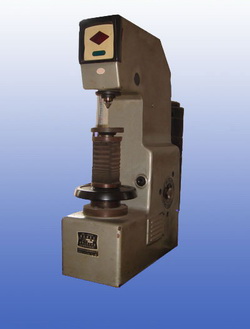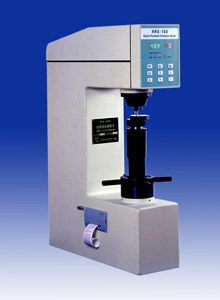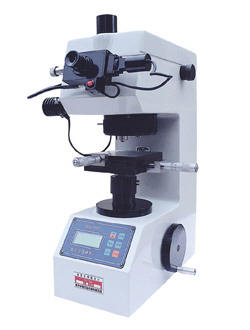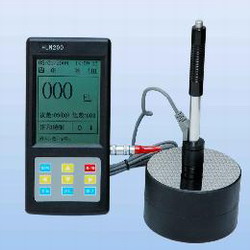| |
The Application of Hardness Tester for Metal Casting
1. Brinell hardness
tester
Brinell hardness is the first option for metal casting hardness
test, especially for the relatively coarse grain
gray iron castings, Brinell
hardness tester is the only choice, and we need to try to choose
3000kg force, 10mm ball test conditions. When the
metal casting size is small,
we can also choose Rockwell hardness tester.
Metal casting hardness test preferred Brinell hardness tester is
due to the following two points:
a. Iron castings' organization is usually uneven and the grains are
larger, the carbon, silicon and other impurities contained are more
than those in steel. The sizes of hardness on different small areas
or points are different. The Brinell hardness tester has larger size
of head and larger indentation and it can detect the average
hardness in a range, so the Brinell hardness tester has a higher
accuracy, and smaller dispersion of hardness values, the hardness
value measured is more representative of the actual state of the
workpiece hardness. So Brinell hardness tester is widely used in the
foundry industry.
b. The tensile strength is the first mechanical property of metal
castings, and almost all of the metal castings standards have
tensile
strength requirements. The Brinell hardness and tensile
strength values have a very close relationship and the two values
can be converted. The tensile strength of gray cast iron can be
counted by the following formula: σb = 1.82 (HB) 1.85
This relationship can also be obtained by look up the table. Brinell
hardness test can help us get the value of the tensile strength
quickly and easily and improve test efficiency and reduce testing
costs.

2. Rockwell hardness
tester
Rockwell hardness tester is also commonly used in the inspection to
cast iron. All the parts with smaller grains, if there is not enough
space for the Brinell hardness test, can be tested by Rockwell
hardness tester. For pearlitic malleable iron, chilled cast iron and
steel castings, HRB or HRC scale can be used, and if the material is
heterogeneous, several readings should be measured to get the
average value.
Rockwell hardness test is quick, convenient and has small
indentation, which can be used to directly test the finished piece.
It is suitable for testing mass production of finished or
semi-finished parts piece by piece.

3. Shore Hardness
Tester
In some cases, for some larger
metal castings, cutting the sample or cast test blocks for
hardness testing is not available, so hardness testing will be
difficult. In this case, the common approach is to use portable
Shore hardness tester on the smooth surface after finishing.
As a result of following the dynamic hardness principle, many
factors affect the result of Shore hardness test; the test accuracy
is much lower than the Brinell hardness tester and Rockwell hardness
tester, which work on the static indentation hardness test
principle. For this reason, in roll standard, Roll hardness
comparison is also recommended, which plays as a standard sample,
and the hardness value is to rely on cutting the sample to get
accurate test. After using Shore hardness tester, you need to check
detection accuracy on the contrast roll.

4. Leeb
hardness tester
Nowadays, Leeb hardness tester is widely used in
metal castings hardness.
Leeb Hardness Tester is improved on the basis of Shore hardness
tester. It is also applied to the principle of dynamic hardness
testing, using computer technology to achieve the miniaturization,
electronization of a hardness tester. It is easy to use, and the
test results can be easily converted into Brinell hardness value,
and it has been widely welcomed.
However, like Shore hardness, Leeb hardness tester accuracy is not
high, many factors can affect test accuracy, such as requiring high
surface finish, conversion tables lacking the authority, and
conversing errors. Therefore, the Leeb hardness test results have
been frequently used as a reference value in our country, and Leeb
hardness tester is mainly used for those metal castings that have a
wider range of requirements. In addition, as a non-formal method,
the Leeb hardness tester is not widely recognized in International
Organization for Standardization, and it has not been used in
Product Standards of metal castings in foreign countries. In
international trade, the hardness test results are not accepted by
most foreign investors.

Many metal castings are quite large,
some weighing several tons, which can not be moved on the hardness
tester desktop. The precise hardness test of metal castings mainly
use test rod that cast separately or a test block attached on metal
castings. However, neither the test rod or test block can fully
replace the part itself, even in the same furnace hot metal, and the
casting and heat treatment conditions are identical, because of the
huge difference in size, both heating rate, especially the cooling
rate are different, the two can hardly get the same hardness, for
this reason, many customers are more concerned with and believe in
workpiece hardness itself, and this requires a portable hardness
tester to test metal casting hardness.
Home |
More Articles |
|
